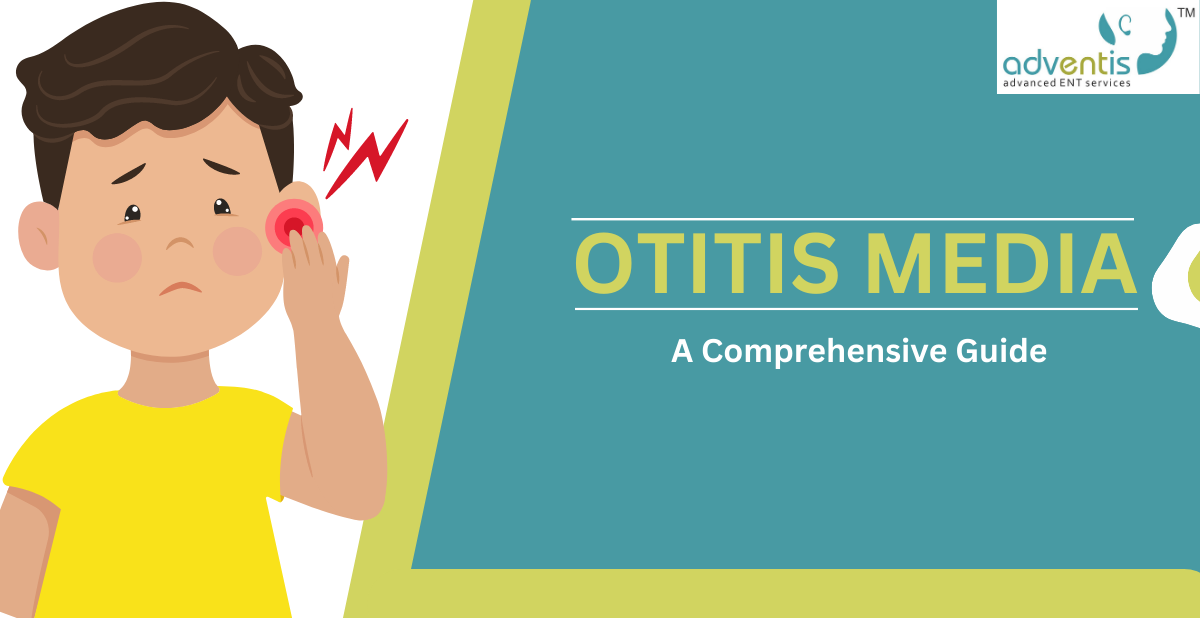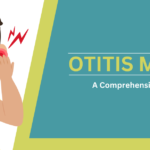Otitis media, commonly known as an ear infection, can cause discomfort and potential complications. In this comprehensive guide, we will explore the causes, symptoms, diagnosis, treatment options, and potential complications associated with recurrent otitis media. Understanding these aspects is crucial for effectively managing and preventing recurrent ear infections.
What causes an ear infection?
Ear infections can occur due to various factors, including bacterial and viral infections. Risk factors such as respiratory infections, younger age, and exposure to certain environments can increase the likelihood of developing otitis media.
Who is most likely to get an ear infection (otitis media)?

Young children, especially those in their early years, are more susceptible to ear infection. Factors such as an underdeveloped immune system, shorter and more horizontal Eustachian tubes, and exposure can contribute to the higher incidence of otitis media in this age group. However, ear infection can affect individuals of any age.
Are ear infections contagious?
Yes, ear infections can be contagious. They can spread through direct contact with an infected individual or through respiratory droplets. It is important to take precautions to prevent the transmission of ear infections, especially in settings where close contact is common.
What are the symptoms of otitis media (middle ear infection)?
Otitis media, commonly known as an ear infection, manifests through various symptoms. Individuals may experience ear pain, discomfort, and a sensation of fullness in the affected ear. In young children, signs such as irritability, difficulty sleeping, and changes in appetite or behavior, along with ear tugging, may indicate the presence of an ear infection.
In certain cases, the accumulation of fluid in the middle ear may necessitate a surgical procedure. To address such situations, clinical practice guidelines are followed to manage hearing difficulties and hearing loss associated with otitis media.
How is an ear infection diagnosed?
Diagnosing an ear infection involves a comprehensive evaluation. A healthcare provider will examine the ear canal, eardrum, and surrounding areas for signs of infection or inflammation. In some cases, a hearing test or assessment of the eardrum’s movement may be conducted to confirm the diagnosis.
How is otitis media diagnosed?
Differentiating between acute otitis media (AOM) and otitis media with effusion (OME) is essential for appropriate management. AOM is characterized by the presence of fluid and inflammation in the middle ear, while OME involves the accumulation of fluid without active infection. Diagnostic procedures, including a thorough medical history, physical examination, and specialized tests, aid in accurate diagnosis.
Role of Eustachian tubes
The Eustachian tubes are vital in preventing and managing ear infections. They are narrow tubes that connect the middle ear to the back of the throat, enabling drainage and equalizing pressure. Several factors that can affect their function include respiratory infection, structural abnormalities, and allergies, which increase the chances of developing ear infections.
It’s essential to gather a complete medical history, including the child’s age, to diagnose and manage ear infections effectively. Clinical practice guidelines recommend pain relief and watchful waiting until the initial infection subsides. Failure to treat ear infections promptly can lead to balance and hearing loss, as well as serious complications. Thus, it’s crucial to seek medical attention promptly if you suspect a viral infection or an ear infection.
How middle ear infections are treated?
The middle ear is a small, air-filled space located behind the eardrum that can become infected due to various factors, including respiratory infections, sore throat, and eustachian tube dysfunction. The severity of the infection, the age of the patient, and the presence of complications determine the treatment plan. Antibiotics are often prescribed for bacterial infections to clear up the infection, relieve pain, and prevent further complications. Over-the-counter pain relievers or ear drops may also be recommended to alleviate discomfort.
Recurrent or chronic cases of middle ear infections may require surgical interventions such as the insertion of ear tubes. These tubes help equalize air pressure in the middle ear and prevent the accumulation of fluid, reducing the frequency and severity of most ear infections thereafter.
If a middle ear infection is suspected, it is important to watch for symptoms such as unusual irritability, difficulty sleeping, and upper respiratory infection. Early detection and prompt treatment can help prevent complications and reduce discomfort.
Ear Infection Treatment
The treatment approach for acute otitis media, commonly known as a middle ear infection, focuses on alleviating symptoms, resolving the infection, and preventing complications. Adhering to the prescribed treatment plan and attending follow-up visits with a healthcare provider is vital for the successful management of middle ear infections.
In some cases, a thorough hearing test may be recommended to assess any potential hearing impairment. Middle ear infections often occur as a result of respiratory infections or sore throats, as bacteria or viruses can travel through the eustachian tube and cause inflammation in the middle ear.
If a child displays unusual irritability or difficulty sleeping, it may be indicative of a middle ear infection. Prompt medical attention and appropriate treatment can help alleviate discomfort and restore normal middle ear function.
What should I expect if I or my child has an ear infection?
When an ear infection, such as acute otitis media or chronic suppurative otitis media, affects the middle ear, common symptoms like ear pain and general discomfort may arise. Prompt treatment is crucial as it helps alleviate these symptoms and promotes faster recovery.
It is vital to closely follow the healthcare provider’s instructions throughout the healing process. Monitoring for any changes or worsening symptoms is also essential. The middle ear, connected to the outer ear by the eustachian tube, is susceptible to developing ear infections. By promptly addressing middle ear infections, individuals can mitigate the associated discomfort and aid in the healing process.
When should I call the doctor about an ear infection?
If you or your child are dealing with severe or persistent ear pain, high fever, drainage of fluid from the ear, or worsening symptoms, it is crucial to seek immediate medical attention.
The eustachian tube, frequent ear infections, chronic otitis media, bacterial infections, respiratory infection, and outer ear are all relevant factors to consider in such cases. Understanding the role of the eustachian tube and the connection between frequent ear infections, chronic otitis media, and bacterial infection or respiratory infections is vital in determining appropriate medical interventions.
Whether it’s an infection in the outer ear or complications related to the eustachian tube, it is essential to consult a healthcare professional for accurate diagnosis and effective treatment.
When should I return to my healthcare provider for a follow-up visit?
Following up with a healthcare provider is essential to evaluate the progress of treatment and ensure the infection is resolved. A follow-up visit should be scheduled as recommended by the healthcare provider.
Can I travel by air or be in high altitudes if I have an ear infection?
Air travel or exposure to high altitudes can significantly impact the pressure within the ears, leading to potential discomfort or exacerbation of symptoms. Therefore, it is highly recommended to seek guidance from a healthcare provider before embarking on such journeys, particularly if children younger, individuals with cleft palate, or those who have undergone neck surgery are involved.
It is crucial to assess the child’s age, medical history extent of the initial infection subsiding, and any balance or hearing difficulties they may experience. Consulting with a healthcare professional is essential to determine the appropriateness of travel.
Untreated or recurrent ear infections:
Untreated or recurrent ear infections can have serious consequences on a child’s health. If left unattended, complications such as persistent fluid accumulation, hearing loss, and damage to the eardrum or surrounding structures may arise. It is essential to see ear infections clear and address them promptly to avoid long-term complications. Administering appropriate ear drops medication and seeking medical advice is crucial.
For infants, breastfeeding can provide some protection as breast milk contains antibodies that help fight infections. In some cases, mild hearing loss may occur as a result of untreated ear infections. Parents should be vigilant for signs such as unusual irritability and difficulty sleeping, which may indicate an ear infection. Taking measures to prevent ear infections, such as keeping the child’s ear clean and dry, can significantly reduce the child’s risk.
Related conditions
Otitis media, commonly known as a middle ear infection, is often associated with other medical conditions that can impact a child’s speech.
Upper respiratory infections can increase the likelihood of developing otitis media. These infections cause inflammation in the nasal passages, leading to blocked Eustachian tubes and a buildup of fluid in the middle ear. The fluid remains trapped behind the tympanic membrane, which can cause pain, discomfort, and even hearing loss.
Frequent infections, especially in very young children, can lead to long-term complications such as language delays, speech problems, and difficulty learning in school. The changes in air pressure that occur during air travel or swimming can also contribute to the development of otitis media.
It’s crucial to be aware of the potential risks associated with otitis media and other related medical conditions.
Risk factors
Several risk factors increase the likelihood of developing ear infections:
Risk factors such as a family history of recurrent infections, young age, exposure to tobacco smoke, and attending daycare or school settings with a high prevalence of respiratory infections.
Most infections are caused by bacterial infections. Common ear infection symptoms include ear pain, fluid drainage, and hearing difficulties. Younger children are particularly susceptible to respiratory infection due to their underdeveloped immune systems and smaller Eustachian tubes. If left untreated, infections can potentially affect the middle ear as well as the inner ear, leading to complications that may impact the child’s hearing.
What are the harms of fluid buildup in your ears or repeated or ongoing ear infections?
Fluid buildup in the middle ear, often caused by respiratory infections, can result in various complications. Persistent hearing loss, delays in speech, and potential impacts on overall health and well-being are among the consequences. Most ear infections, typically triggered by bacterial infections, contribute to these issues.
Younger children, due to their immature immune systems and smaller Eustachian tubes, are particularly susceptible frequent ear infections. The inner ear, crucial for transmitting sound signals to the brain and spinal cord, can be affected, impairing a child’s hearing. Recognizing common ear infection symptoms and seeking timely medical intervention are essential to mitigate these risks and ensure optimal auditory and developmental outcomes for children.
Problems with speech and language development:
Persistent ear infections, also known as chronic otitis media, can significantly disrupt speech and language development in children. These infections often originate from nasal passages and can lead to a range of complications. One of the primary concerns is the potential impact on communication skills. The middle ear, responsible for transmitting sound to the inner ear and then the brain may suffer from inflammation and fluid buildup due to infections. This can result in balance issues and hearing loss, affecting a child’s ability to perceive and produce speech accurately.
Furthermore, recurrent infections can contribute to the enlargement of lymph tissue located near the ear canal, further exacerbating the problem. Early intervention and appropriate management, including the treatment of underlying causes such as infections, are crucial in mitigating the potential long-term consequences on speech and language development in affected children.
Why do children get many more ear infections than adults?
Children are more prone to ear infections:
Due to various factors, including anatomical differences, an immature immune system, and increased exposure to respiratory infections. Also, the diagnosis may be made in children who have mild bulging of the ear drum and intense erythema (redness) of the ear drum. To confirm the diagnosis, middle-ear effusion and inflammation of the eardrum have to be identified. However, as children grow older, their risk for ear infections generally decreases.
Recurrent or severe infections can potentially lead to more significant hearing loss, and it may be necessary to test eardrum movement or consider antibiotic medication. Clinical practice guidelines recommend assessing the child’s pain and providing appropriate relief. It is worth mentioning that while ear infections are more common in children, they can also affect adults and older children. With proper care and timely intervention, the impacts can be minimized for the the child’s hearing and overall well-being.
The Impact of Acute Otitis Media on Children
Otitis media is a common condition characterized by ear pain, discomfort, and a feeling of fullness in the affected inner ear. Young children may display signs such as irritability, difficulty sleeping, changes in appetite or behaviour, and tugging at the ears, which may indicate the presence of an ear infection. Temporary hearing loss and balance difficulties can also occur. Otitis media is often caused by fluid in the middle ear, which can be treated with antibiotics or by monitoring the condition to see if it improves on its own. In some cases, a surgical procedure may be necessary to remove the fluid. Clinical practice guidelines recommend appropriate diagnosis and treatment for balance hearing loss.
Timely medical attention, adherence to treatment plans, and appropriate preventive measures can help mitigate the impact of infections and promote ear health throughout life. If you or your child experiences symptoms of an ear infection, it is advisable to consult with a healthcare provider for proper evaluation and guidance.











